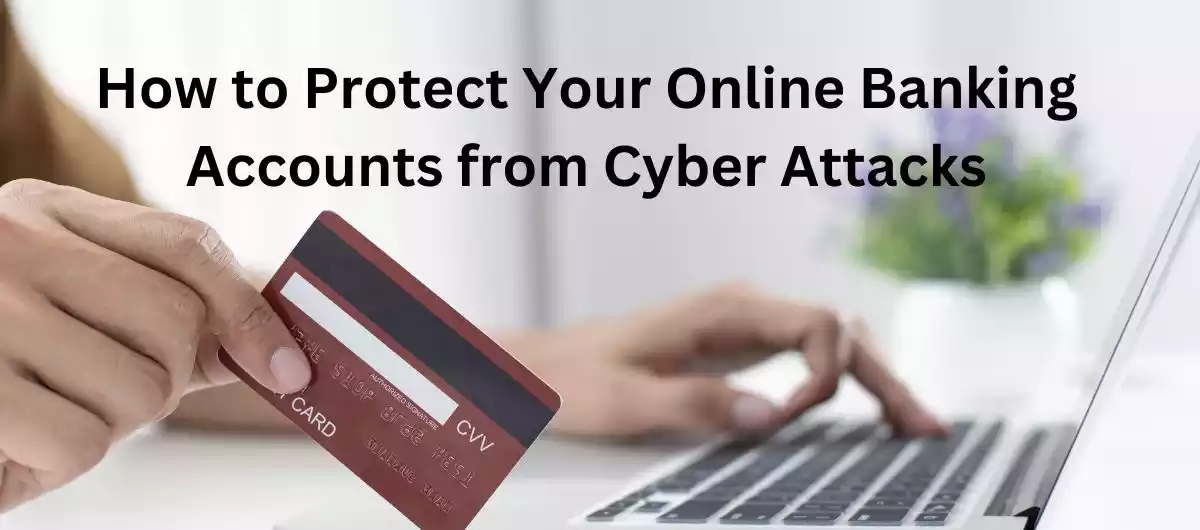In today’s digital world, online banking has become a ubiquitous and indispensable part of our daily lives. It is a convenient, secure and efficient way to manage our finances from the comfort of our own homes. However, with the increased use of technology there is increased the risk of cyber attacks, making it essential to protect your online banking accounts from potential threats. Some of the best practices you should follow to protect your online banking accounts are : Use Strong Passwords, Enable Two-Factor Authentication, Keep Your Computer Secure, Be Cautious When Using Public Wi-Fi and , Monitor Your Accounts Regularly
In this article, you will read the best practices on how to protect your online banking accounts from cyber attacks so that you can safeguards your online banking information and protect your banling accounts:
Contents
What is Online Banking?
Online banking is a Internet based service offered by financial institutions that allows you to manage your finances at ease from remote place. The online service is normally available 24/7 and enables you to perform a wide range of financial transactions, such as checking your account balance, transferring funds, paying bills and more. With the rise of smartphones and mobile devices, online banking has become even more accessible and convenient.
Types of Cyber Threats for Online Banking Accounts
It is important to be aware of the different types of cyber threats that are more common for online banking accounts and accordingly to take the necessary steps to protect yourself and your finances. Before proceed to know the best practices, you should have some fair idea on types of cyber threats to the online personal banking accounts. There are several types of attacks that you should be aware of, including phishing scams, malware attacks, and password theft.
Phishing Scams
Phishing scams are a type of attack where criminals impersonate a trustworthy entity, such as your bank entity, in an attempt to steal your personal information or login credentials. These scams often come in the form of emails, text messages, or phone calls, and are designed to trick you into clicking on a link or entering sensitive information.
Malware Attacks
Malware attacks are another type of cyber attack that can target your online banking information. Malware is a type of software that is designed to damage your computer or steal your personal information. Some common types of malware include viruses, Trojans, and spyware. To protect against malware, it is important to use a reputable anti-virus software and to be cautious when downloading or opening attachments from unknown sources.
Password Theft
Password theft is another type of attack that can target your online banking information. In this attack, hackers try to steal your login credentials by using techniques like brute force attacks, keyloggers, or by phishing scams.
Phishing Scams
Phishing scams are one of the most common types of cyber threats for online banking accounts. These scams often take the form of emails or text messages that appear to be from a trusted source, such as your financial institution, asking you to click on a link or provide personal information. The goal of these scams is to steal sensitive information, such as login credentials or financial information, which can be used for identity theft or other malicious purposes.
Man-in-the-Middle Attacks
Man-in-the-middle attacks occur when an attacker intercepts the communication between you and your financial institution, stealing sensitive information in the process. To protect against these attacks, it is important to ensure that your online banking sessions are encrypted and that you are accessing a legitimate website.
Social Engineering Attacks
Social engineering attacks are attempts to trick you into revealing sensitive information, such as login credentials or other personal information. These attacks often take the form of phone calls or emails posing as trusted sources, and can be difficult to detect. To protect against social engineering attacks, it is important to be cautious when providing personal information and to verify the identity of the person or entity asking for it.
Best Practices to Protect Your Online Banking Accounts
After having some fair idea on different types of threats you may face, let’s take a look at some best practices you can follow to protect your online banking accounts.
Always Use Strong Passwords
One of the most important things you can do to protect your online banking information is to use strong passwords. A strong password should be at least 12 characters long and contain a mix of upper and lowercase letters, numbers, and symbols. You should also avoid using easily guessable information, such as your name, birthdate, or social security number.
Must Enable Two-Factor Authentication
Two-factor authentication is an added layer of security that requires you to enter a code, sent to your phone or email, in addition to your password. This makes it much harder for criminals to access your account, even if they manage to steal your login credentials.
Keep Your Computer Secure
Keeping your computer secure from maliciaos software is essential way to protect your online banking information. This way you should keep your computer and software up-to-date, use a reputable antivirus program, and be cautious when downloading files or visiting websites.
Avoid When Using Public Wi-Fi
Public Wi-Fi networks are often unsecured, which makes it easy for criminals to intercept your information. To protect your online banking information, avoid using public Wi-Fi networks for sensitive transactions, and only use trusted, secure networks. You may also read the article on How To Safely Use Public Wi-Fi Networks
Monitor Your Banking Accounts Periodically
Finally, it’s important to regularly monitor your online banking accounts. In order to minimize these risks and protect your hard-earned money, it is essential to monitor our online banking accounts regularly to ensure there are no unauthorized transactions or suspicious activity. If you notice anything unusual, contact your bank immediately to report the issue.
Conclusion
By following these best practices, you can significantly reduce your risk of having your online banking information compromised. Protecting your online banking accounts from cyber threats requires a combination of best practices and common sense. As explained above, some of best practices are using strong passwords, enabling two-factor authentication, regularly monitoring your accounts, being cautious when providing personal information, and using a reputable anti-virus software. By following these best practices, you can help reduce the risk of cyber threats and ensure the safety of your financial information.
Stay vigilant and stay protected.
FAQs : How to Protect Your Online Banking Accounts from Cyber Attacks
1. What is two-factor authentication?
2. How can I keep my computer secure when using online banking?
Answer: There are several steps you can take to keep your computer secure when using online banking:
- Keep your operating system and software up-to-date: Regularly updat your operating system and software that can help to patch security vulnerabilities and prevent malware from exploiting them.
- Use a reputable antivirus software: Antivirus software can help you to protect your computer from malware, viruses, and other threats.
- Enable firewalls: Firewalls act as a barrier between your computer and the internet, helping to prevent unauthorized access to your system.
- Use a secure network: When using online banking, make sure you are connected to a secure Wi-Fi network. Avoid using public Wi-Fi networks, as they may not be secure.
- Use strong, unique passwords: Use strong, unique passwords for your online banking accounts, and avoid using the same password for multiple accounts. Consider using a password manager to help generate and store strong passwords.
- Be cautious when opening emails and attachments: Be wary of emails and attachments from unknown sources, as they may contain malicious links or attachments.
- Be careful when clicking on links: When using online banking, avoid clicking on links in emails or on websites unless you are sure they are legitimate.
3. Is it safe to use public Wi-Fi networks for online banking?
Answer: No, it is not recommended to use public Wi-Fi networks for online banking as they are often unsecured and make it easier for criminals to intercept your information.
4. What should I do if I notice suspicious activity on my online banking account?
Answer : If you notice any suspicious activity on your online banking account, it’s important to contact your bank customer care immediately to report the issue.
5. How often should I monitor my online banking account?
Answer : It’s recommended to regularly monitor your online banking account, at least once a week, to ensure there are no unauthorized transactions or suspicious activity.
Also Read: 10 Essential Cyber Security Tips For Small Business


1 thought on “How to Protect Your Online Banking Accounts”